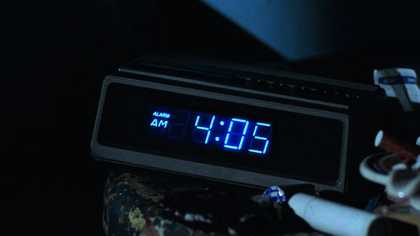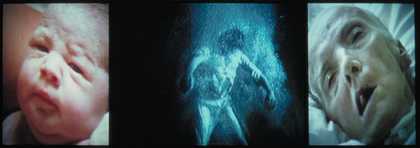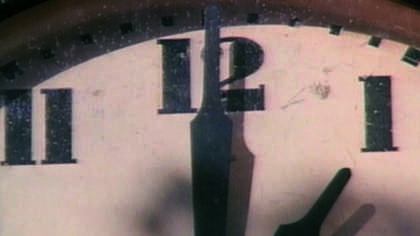
Christian Marclay The Clock 2010. Single channel video, duration: 24 hours © the artist. Courtesy White Cube, London and Paula Cooper Gallery, New York
The Clock by artist Christian Marclay is a 24-hour long montage of thousands of film clips that depict clocks or reference time. The film has been edited so that it is a functioning timepiece. Watch it and you will find that the time displayed on screen will be the same as on your watch or smartphone. However, The Clock is much more than your average time-teller. Here are five reasons why
1. It’s more interesting than looking at your watch
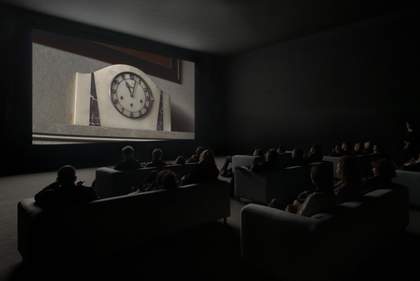
Christian Marclay The Clock 2010. Single channel video, duration: 24 hours Photographer: White Cube (Ben Westoby)
Watching The Clock is a trance-like experience, almost hallucinogenic; you're liable to see things that aren't there.
Zadie Smith
The Clock took three years to compile. Marclay and his team of six assistants searched through hours and hours of film footage to find references to the time. Marclay painstakingly knitted clips together to form one film.
Watching The Clock, you will see time displayed through sundials, hourglasses, grandfather clocks, pocket watches, blinking microwave LEDs - and the list goes on. The Clock is an entirely immersive experience. You become absorbed by the different ways that the time is represented in film. In watching The Clock, you are watching time, rather than thinking about how little of it you have left. In the fast-paced society we live in today, that is quite a luxury.
2. It tells a story
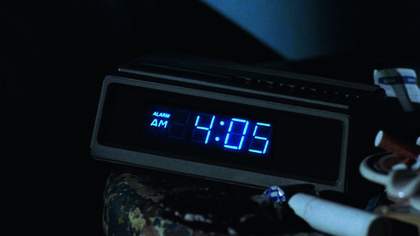
Christian Marclay The Clock 2010. Single channel video, duration: 24 hours © the artist. Courtesy White Cube, London and Paula Cooper Gallery, New York
The Clock suggests there is a pattern of behaviour in how we spend our time. Unconsciously many of us do the same things at particular moments in the day. Many people wake up, travel to work and go to bed at the same time. Marclay seems to be commenting on how we are connected through these shared moments.
There is no one single narrative though. The final artwork contains around 12,000 moments from different films. The Clock tells the story of humanity rather than a series of characters. We might try and find a linear plot, but it is impossible. Time links each of the clips. The landscape of Marclay’s film changes so often and yet comes together to form one whole. The story is the story of time and how it progresses throughout the day.
3. It’s an experience for the ears as much as the eyes
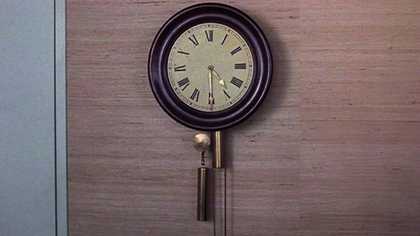
Christian Marclay The Clock 2010. Single channel video, duration: 24 hours © the artist. Courtesy White Cube, London and Paula Cooper Gallery, New York
Marclay has always been interested in the relationship between sound and image. He started out in the underground music scenes in Boston and New York in the late 1970s. The original idea for The Clock came when he was editing his video score Screen Play, a collage of film clips overlaid with graphic animations which live musicians responded to.
When editing The Clock, Marclay had to think of how the audio could transition smoothly into the next clip. Using the pre-existing sounds in the clips, he wove them together to essentially create a new score. Similarly, Marclay’s earlier work Video Quartet 2002 created a 14 minute composition made from over 700 film clips.
Watching The Clock the viewer is transported by the soundscape of the piece. In a strange alternative to the tick-tocking of a clock, Marclay uses sound and music to trace the rhythm and the passage of time.
4. It’s a journey through cinematic history
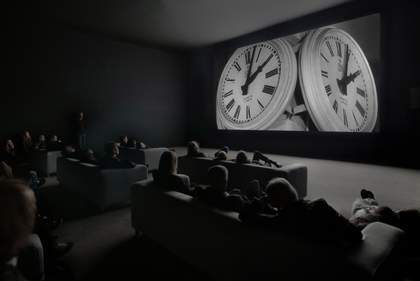
Christian Marclay The Clock 2010. Single channel video, duration: 24 hours Photographer: White Cube (Ben Westoby)
For film fans, The Clock takes the viewer through the last century of filmmaking. Audiences will be able to recognise films such as Pulp Fiction (1994), Breakfast at Tiffany’s (1962) and Titanic (1997). Some famous faces also make an appearance. See if you can spot actors like Colin Firth, Jodi Foster and Al Pacino.
The Clock becomes a homage to cinema that deals with and represents time. It shows dialogue that might seem insignificant, but in this new context emphasises how these characters and the writers of these films are influenced and framed by time.
5. It’s a memento mori
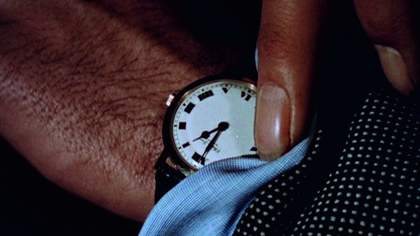
Christian Marclay The Clock 2010. Single channel video, duration: 24 hours © the artist. Courtesy White Cube, London and Paula Cooper Gallery, New York
By inviting an audience to come and watch his film, Marclay asks them to consider the implications of time. It is constantly present and when watching the film, it’s near impossible to ignore its significance.
The Clock is very much about death in a way. It is a memento mori. The narrative gets interrupted constantly and you’re constantly reminded of what time it is. So you know exactly how much time you spent in front of The Clock.
Christian Marclay
The film has the ability to make you think about past, present and future. It is composed of moments from the past, but the ever-moving clock that matches your own real time places an emphasis on the present. Knowing that time continues to tick, it asks you to consider the future. Marclay asks what you will do with it in your restricted time frame. The Clock has the ability to make us present in the moment. It asks us to consider time, rather than misuse it. For that reason, it is perhaps the most important timepiece we will ever encounter.
Christian Marclay The Clock is at Tate Modern, 14 September 2018 – 20 January 2019

